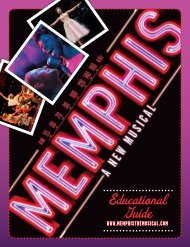Cameron Mackintosh And The Really Useful Theatre ... - Telecharge
Cameron Mackintosh And The Really Useful Theatre ... - Telecharge
Cameron Mackintosh And The Really Useful Theatre ... - Telecharge
You also want an ePaper? Increase the reach of your titles
YUMPU automatically turns print PDFs into web optimized ePapers that Google loves.
of the “locked room” mysteries, where an impossible murder is<br />
committed in a sealed room.<br />
A great admirer of Edgar Allen Poe and Sir Arthur Conan Doyle, the<br />
creator of Sherlock Holmes, Leroux later said “I knew that I must do<br />
better than Poe and Conan Doyle, so I decided to have a murder<br />
committed in a room which was hermetically sealed, as closed as a safe,<br />
in fact.”<br />
In his 1942 treatise on the mystery genre, Murder for Pleasure, Howard<br />
Haycraft noted, “<strong>The</strong> Mystery of the Yellow Room is generally<br />
recognized, on strength of its central puzzle, as one of the classic<br />
examples of the genre.”<br />
IDEAS FOR RESEARCH & DISCUSSION<br />
� It is said that one out of every four books published in the English language<br />
is a mystery or detective novel. Why is this genre so popular?<br />
� Edgar Allan Poe, known for his macabre tales and poems, is also known as<br />
the “Father of the Detective novel.” Find out why.<br />
T<br />
he hero of <strong>The</strong> Mystery of the Yellow Room is a young star reporter<br />
named Joseph Rouletabille, mocked and shunned for his fierce<br />
independence and his unusually large head. In Rouletabille, we can<br />
hear a whisper of the despair and detachment that would eventually<br />
coalesce in his greatest creation, Erik, the malformed Phantom of the<br />
Opera, as well as, perhaps, a glimpse of Leroux himself. Like the<br />
Phantom, Rouletabille’s ugly appearance is a mask that hides a brilliant,<br />
lonely mind.<br />
Leroux’s career as a novelist flourished. He wrote six more Rouletabille<br />
novels and sixty other novels of adventure, romance and horror.<br />
At Last, the Phantom<br />
n 1911, during one of his frequent visits to the Paris Opera House,<br />
I<br />
Leroux began to hear rumors of a ghost that haunted the old<br />
building. Several unexplainable deaths had been attributed to this<br />
spectre, and backstage gossip only fueled the story. <strong>The</strong> Opera House<br />
had already had its share of mysterious accidents: on May 20, 1896, a<br />
counterweight of the seven ton chandelier had fallen into the audience,<br />
killing a concierge named Mme. Chomette. His reporter’s instincts<br />
aroused, Leroux studied the Opera House, exploring it from the slimy<br />
underground caverns to the dizzying pinnacles of its rooftops.<br />
Leroux saw in the Opera House a mirror of the Belle Époque society that<br />
passed through its halls: beautiful, stately and refined on the outside, but<br />
just below the surface, a dark undercurrent of secrecy and horror. In a<br />
feverish three months, often bounding out of bed in the middle of the<br />
8 <strong>The</strong> Study Guide for THE PHANTOM OF THE OPERA





